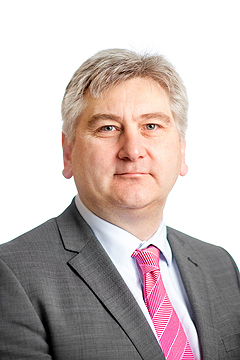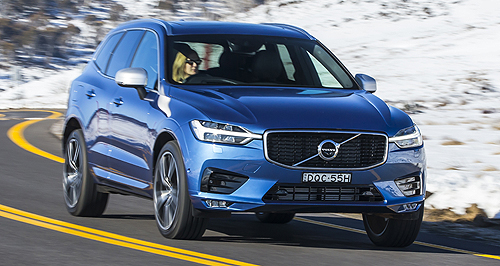Make / Model Search
News - VolvoVolvo aims to double local sales by 2020Going gangbusters: Volvo has been forced to increase production of its new XC40 SUV to meet demand. 10,000 sales a year the short-term target for Volvo via new models, improved supply8 May 2018 By TERRY MARTIN VOLVO Car Australia’s new managing director Nick Connor has identified 10,000 annual sales as an achievable target by 2020 – more than double last year’s volume – as new models such as the just-launched XC40 small SUV hit the market. The company will also invest more heavily in areas such as marketing and dealerships in an effort to improve its brand image and representation, while Mr Connor’s strong connections back in Volvo Cars’ Gothenburg headquarters, where most recently he served as vice-president in charge of Europe, the Middle East and Africa, will also be crucial in unlocking supplies of key models. The latter is centred on its burgeoning SUV range, which as well as XC40 includes the larger XC60 and XC90. In an interview with GoAuto last week, Mr Connor made it clear that Volvo – which recorded 4681 sales last year (down 20.4 per cent on 2016) and over the past decade has consistently sold between 4469 and 5878 units – was underperforming in Australia, and that the growth potential was what attracted him to the role. He has already extended this year’s year-on-year growth forecast to at least 35 per cent – targeting more than 6500 units after sales have climbed 26.3 per cent to the end of April – which will include up to 1700 examples of the XC40 and improved supplies of the popular XC60, which is expected to push up to about 3000 units this year (up from 1900 in 2017).  Left: Volvo Car Australia managing director Nick Connor Left: Volvo Car Australia managing director Nick Connor“Frankly, given enough investment and enough product, I think with our current product portfolio 10,000 is a very realistic number for the Australian market,” he said. “We will see growth of around 35 per cent this year versus last year – we’ll do over 6500 cars this year – and frankly I think given the interest we’re seeing in both XC40 and XC60, and XC90, we could do more if we could get more product. “To give you an idea of the scale of that interest, we’ve taken around a third of our full year’s supply of orders on XC40 in just over a month – we launched the car at the end of April, we’ve taken around 500 orders and our annual supply is 1600-1700 cars. “So this year we’re going to be more constrained by supply than we are by demand and I really don’t see that 10,000 cars (by 2020) is unrealistic. “Frankly, in the slightly longer term, I think we can do more than that.” Mr Connor is working on XC40 volume increasing to about 3000 units next year as production frees up, with the potential to reach “maybe even 4000 or 5000” in the longer-term. “And that way you can see how we are starting to build to 10,000 and beyond,” he said. Volvo’s SUVs currently account for about two-thirds of its sales in Australia – and rising – and Mr Connor said the XC40’s arrival in a fast-growing segment provided the company with “the opportunity to start to really invent some of that volume growth”. “To do that, it’s not just about product, it’s about investment in market, it’s about investment in the brand,” he said. “You’ve probably got a better idea than I have how the Volvo brand is perceived in Australia, but it does seem to me that we still have work to do here. “I don’t think the Australian view of that is very different from a lot of markets around the world, which is that Volvo is a very worthy brand, renowned for our safety heritage and our quality, but is seen more as an intellectual purchase rather than an emotional purchase. “The product perception is probably still rooted in cars that we were making 10 or 20 years ago rather than in the cars that we make today. “So I think we have a job to do … to make the wider consumer aware of what our product portfolio is. I think we’ve got the best design language in the industry at the moment, we’ve got fabulous interiors and connectivity within the cars, so technologically we are very advanced, but people don’t automatically associate Volvo with that. “We’ve got a job to do to tell people about our cars, tell people about what the brand really stands for, and we’re not going to move away from safety – that’s an absolute cornerstone for us – but we need to put a twist on it and try and make it a little bit more engaging and exciting for people.” Mr Connor said he had challenged the company’s marketing agency to be more innovative and that “we should be prepared to take a few risks”. “We’ve certainly got some great global campaigns that have come out of Sweden that I think support where the brand is going,” he said. “Our task here is not to completely reinvent the wheel but to put a tweak on the messaging that comes out of the centre and make it relevant to the Australian market. “We have a different need here. The stuff that comes out of Sweden is from a market where we’ve got 20 per cent market share … Here, we’ve just got to accept that for the moment we are a bit-part player and that we need to really shout a bit louder than we have in the past to make people aware of what we are.” The XC40 campaign feeds into this new direction, taking a different approach that Mr Connor said highlights “the minimalism, in some sense, of that car – that it’s everything you need and nothing you don’t”. Asked about his impressions of the Australian market, Mr Connor, who over more than 20 years with Volvo has also served as the inaugural president of Polestar and head of its UK operations, said he was “genuinely surprised” at how different things operate here compared to Europe and North America. “I’ll be very honest, I wasn’t at all familiar with the Australian market other than, you know, the numbers that I saw for Volvo,” he said. “When I was initially spoken to about the possibility of the role, I did a bit more research as you would expect and looked at the numbers, and it seemed to be there was an opportunity there for Volvo to grow, which is what attracted me to come here. “This is a very different market and I was genuinely surprised at how different it is from, frankly, most of the European markets that I’ve worked in, and North America. I mean, it’s structure, it’s very skewed obviously towards utes, which isn’t the case outside of North America. “I think there’s a strong premium brand position in here – particularly with the German brands – and my takeout, really, was Volvo was doing okay, but wasn’t doing brilliantly here and I saw an opportunity to do better. “I come from a global perspective where we have market share that goes from virtually nothing, all the way up to over 20 per cent in Sweden. “In the UK, we had just under two per cent, selling 45,000 cars a year, and I tell people that I’m old enough to remember a time when Volvo outsold Audi globally.”  Read more2nd of May 2018  Driven: All-new XC40 adds ‘wow factor’ to Volvo line-upVolvo shuns downsizing design trend for all-new XC40 small SUV now on sale26th of March 2018  Volvo undercuts competition with first XC40 small SUVPremium small SUVs put on notice as Volvo XC40 goes after price leadership |
Click to shareVolvo articlesResearch Volvo Motor industry news |











Facebook Twitter Instagram